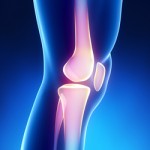Omaha Joint Replacement
View the Total Knee Replacement Animation by Dr. Darren R Keiser MD
Omaha Total Joint Replacement Information
Total Joint Replacement Information by Dr. Darren R. Keiser MD
 A joint is formed by the ends of two or more bones that are connected by thick tissues. For example, the knee joint is formed by the lower leg bone (tibia and fibula) and the thighbone (femur). The hip is a ball and socket joint, formed by the upper end of the femur (the ball), and a part of the pelvis, called the acetabulum (the socket).
A joint is formed by the ends of two or more bones that are connected by thick tissues. For example, the knee joint is formed by the lower leg bone (tibia and fibula) and the thighbone (femur). The hip is a ball and socket joint, formed by the upper end of the femur (the ball), and a part of the pelvis, called the acetabulum (the socket).
The bone ends of a joint are covered with a smooth layer called cartilage. Normal cartilage allows nearly frictionless and pain-free movement. When the cartilage is damaged or diseased by arthritis, joints become stiff and painful. Every joint is enclosed by a fibrous tissue envelope or a capsule with a smooth tissue lining, called the synovium. The synovium produces fluid that reduces friction and wear in a joint.
The goal is to relieve the pain in the joint caused by the damage done to the cartilage. The pain may be so severe, a person will avoid using the joint, weakening the muscles around the joint and making it even more difficult to move the joint. A physical examination, and possibly some laboratory tests and X-rays, will show the extent of damage to the joint. Total joint replacement will be considered if other treatment options will not relieve the pain and disability.
What is Total Joint Replacement?
An arthritic or damaged joint is removed and replaced with an artificial joint, called a prosthesis.
You will be given an anesthetic and the surgeon will replace the damaged parts of the joint. For example, in an arthritic knee the damaged ends of the bones and cartilage are replaced with metal and plastic surfaces that are shaped to restore knee movement and function.
In an arthritic hip, the damaged ball (the upper end of the femur) is replaced by a metal ball attached to a metal stem fitted into the femur and a plastic socket is implanted into the pelvis, replacing the damaged socket.
Although hip and knee replacements are the most common joint replaced, this surgery can be performed on other joints, including the ankle, foot, shoulder, elbow, and fingers.
The materials used in a total joint replacement are designed to enable the joint to move just like a normal joint.
The prosthesis is generally composed of two parts: a metal piece that fits closely into a matching sturdy plastic piece. Several metals are used, including stainless steel, alloys of cobalt and chrome, and titanium. The plastic material is durable and wear resistant (polyethylene). A plastic bone cement may be used to anchor the prosthesis into the bone.
Joint replacements also can be implanted without cement when the prosthesis and the bone are designed to fit and lock together directly.
Most older persons can expect their total joint replacement to last a decade or more. It will give years of pain-free living that would not have been possible otherwise.
Younger joint replacement patients may need a second total joint replacement. Materials and surgical techniques are improving through the efforts of orthopaedic surgeons working with engineers and other scientists.
The future is bright for those who choose to have a total joint replacement to achieve an improved quality of life through greater independence and healthier pain-free activity.
Your orthopaedic surgeon is a medical doctor with extensive training in the diagnosis and nonsurgical and surgical treatment of the musculoskeletal system, including bones, joints, ligaments, tendons, muscles, and nerves.
